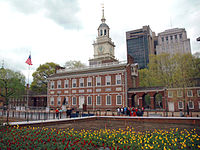| President of the United States in Congress Assembled | |
|---|---|
 | |
| Continental Congress | |
| Style |
|
| Status | Presiding officer |
| Appointer | Vote within the Congress |
| Formation | September 5, 1774 |
| First holder | Peyton Randolph |
| Final holder | Cyrus Griffin |
| Abolished | November 2, 1788 |
| This article is part of a series on the |
| United States Continental Congress |
|---|
 |
| Predecessors |
| First Continental Congress |
| Second Continental Congress |
| Congress of the Confederation |
| Members |
| Related |
|
|
The president of the United States in Congress Assembled, known unofficially as the president of the Continental Congress and later as president of the Congress of the Confederation, was the presiding officer of the Continental Congress, the convention of delegates that assembled in Philadelphia as the first transitional national government of the United States during the American Revolution. The president was a member of Congress elected by the other delegates to serve as a neutral discussion moderator during meetings of Congress. Designed to be a largely ceremonial position without much influence, the office was unrelated to the later office of President of the United States.[1]
Upon the ratification of the Articles of Confederation and Perpetual Union, which served as new first constitution of the U.S. in March 1781, the Continental Congress became the Congress of the Confederation, and membership from the Second Continental Congress, along with its president, carried over without interruption to the First Congress of the Confederation.
Fourteen men served as president of Congress between September 1774 and November 1788. They came from nine of the original 13 states: Virginia (3), Massachusetts (2), Pennsylvania (2), South Carolina (2), Connecticut, (1), Delaware (1), Maryland (1), New Jersey (1), and New York (1).[2]
- ^ Ellis 1999, p. 1.
- ^ Morris 1987, p. 101.